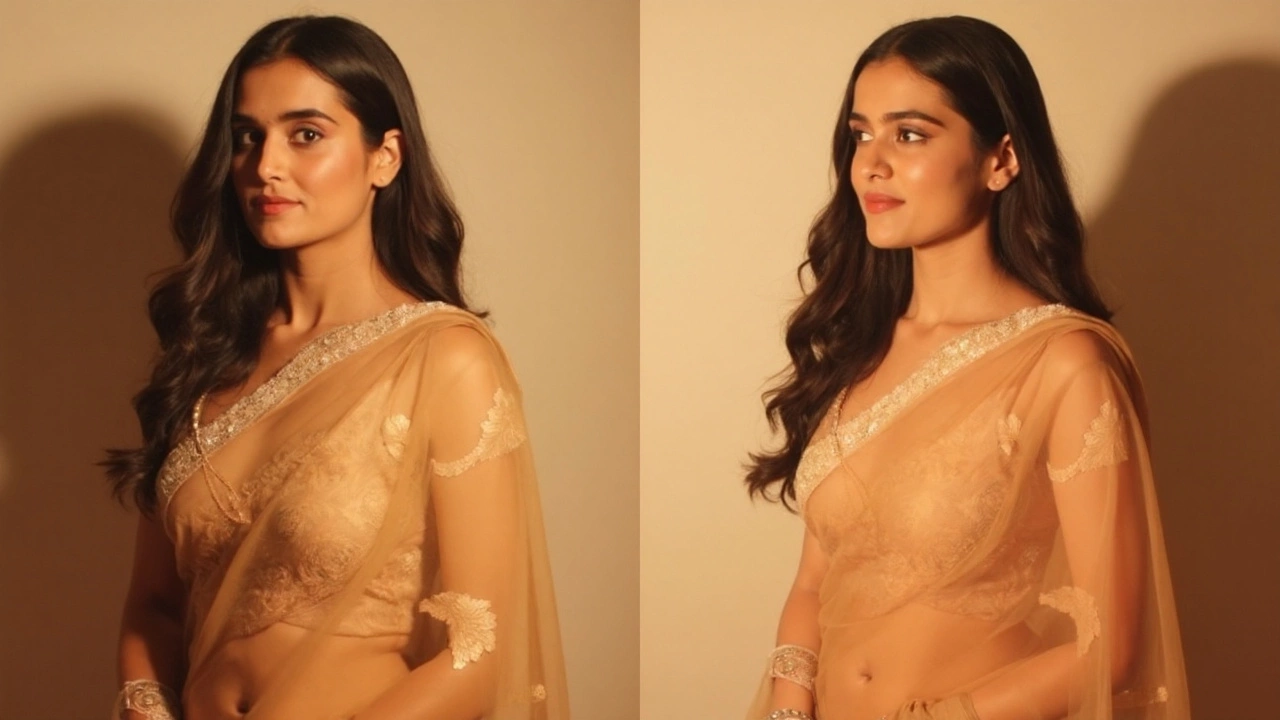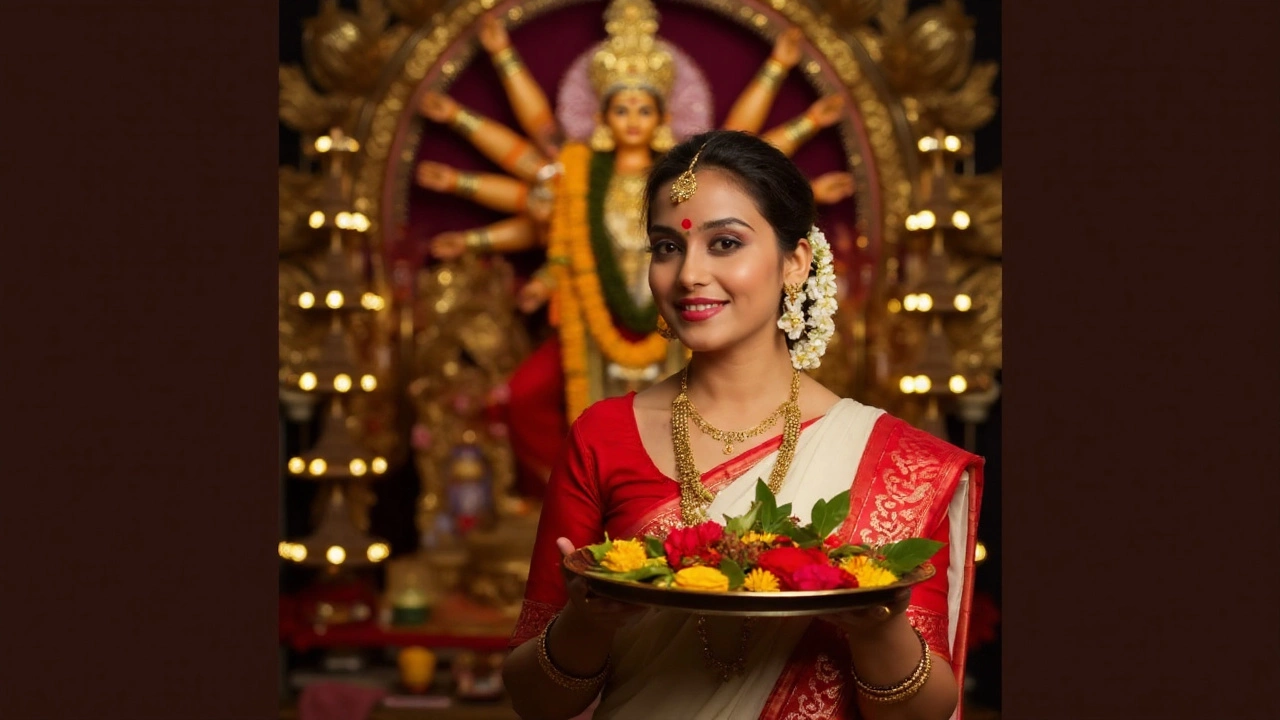What’s driving the Durga Puja saree portrait boom
Festivals put a spotlight on the camera roll. This year, Instagram feeds filled up with lavish Durga Puja and Navratri portraits that look like they were shot in a studio with a full crew. The twist: most started as casual selfies. At the center of the trend is Google Gemini, with creators leaning on the Gemini app and what many posts jokingly call the Nano Banana feature to generate saree looks with goddess-style backdrops and cinematic lighting.
The formula is simple and sticky: upload a photo, write a detailed prompt, and let the model turn a regular shot into a festive portrait. The outputs lean into cultural cues people recognize instantly — red-and-white Bengali sarees, golden aarti light, temple arches, shola flower headpieces, and rim-lit silhouettes. It has the same viral energy we saw with AI avatar apps in late 2022, but here the context is unmistakably local: pandal-hopping, dhaak beats, and a color palette that screams Pujo.
Gemini’s appeal is speed and accessibility. You don’t need a DSLR, a makeup artist, or a palace for a backdrop. If the prompt is specific — saree fabric, drape style, jewelry, lighting direction, and mood — results land surprisingly close to a planned photoshoot. That specificity is the difference between a muddy filter and a portrait people actually save and share.
Yes, there’s also a culture story here. These edits fuse heritage aesthetics with AI polish. Some viewers celebrate the creativity and reach; others worry about AI flattening diverse regional styles into one glossy template. Both can be true. The trend also exposes practical questions — who owns the generated image, should creators label AI work, and how do boutiques or photographers use this responsibly during peak season?

How to create, refine, and share the look
Here’s a straight, no-nonsense path to getting a share-worthy result, plus the prompts powering most of the viral posts.
Step-by-step basics
- Open the Gemini app and start a new image task. Upload a clear selfie or waist-up photo with good front light. Avoid sunglasses or heavy shadows.
- Write a detailed prompt that spells out saree color, fabric, drape, jewelry, lighting, background, pose, and mood. The more concrete, the better.
- Generate multiple versions. Save your favorites. If a detail looks off — hands, jewelry, fabric texture — tweak the prompt and rerun.
- Make light touch-ups only if needed. Crop for composition, adjust warmth, and keep skin tones natural to avoid the plastic look.
- Label your post if it is AI-assisted, especially if you are a brand or a photographer. It builds trust and avoids confusion with real event photos.
Five prompts that actually work
- Classic Durga Puja Portrait: 4K realistic portrait. Woman in red and white saree, shakha-pola bangles, gold jhumkas, subtle festive makeup. Warm golden aarti lighting, soft cinematic glow, shallow depth of field. Background hint of a traditional puja setup, gentle smoke bloom, calm expression.
- Vintage Royal Look: 4K portrait with an artsy, old-world vibe. Long wavy black hair over shoulders. Translucent red saree draped over one shoulder, fitted blouse, white flowers tucked behind right ear. Soft warm light from the right casting a clean shadow on a plain, warm-toned wall. Graceful, poised gaze slightly to the right.
- 90s Bollywood Inspired: Grainy yet vibrant portrait with a romantic, windy feel. Purple chiffon saree, dark brown silky hair, a single small flower in the hair. Backlight to rim the hair, pastel background blur, light film grain for a 90s cinema texture.
- Palace Setting: Young Indian woman in a vintage saree standing in a royal palace corridor. Ornate arches and carved pillars, warm golden hour light with long shadows. Cinematic composition, balanced highlights, subtle dust motes in the air, serene expression.
- Studio Portrait Style: Traditional red silk saree, seated on an antique chair, studio photography look. Softbox-style key light, gentle fill, soft shadow falloff. Neutral backdrop in warm tones, classic portrait pose, crisp texture on silk and jewelry.
Dialing in the look: what to specify
- Saree fabric: Banarasi, Kanjeevaram, Dhakai Jamdani, chiffon, cotton, tussar. Fabric choice changes sheen and drape.
- Drape and blouse: Bengali atpoure drape vs Nivi drape, sleeveless or elbow-length blouse, back tie details, border thickness.
- Jewelry: Nath nose ring, choker with temple motifs, layered necklaces, kadas, shakha-pola, maang tikka, kamarbandh. Name two or three so it does not overload.
- Makeup: Soft kohl-lined eyes, warm nude lip, classic red bindi, subtle highlighter. Ask for skin texture preserved to avoid plastic skin.
- Lighting: Warm golden aarti light, Rembrandt-style key light, rim light from the back, haze for atmosphere. Mention soft-edged shadows and a single light direction.
- Background: Pandal details, brass lamps, shola art, temple arches, or a clean studio backdrop. Keep one clear theme per image.
- Pose and framing: Three-quarter portrait, gentle head tilt, hands loosely joined, eyes looking off-camera right, 4:5 or 3:4 portrait crop.
Troubleshooting common glitches
- Hands or jewelry look odd: Reduce jewelry complexity in the prompt and simplify the pose. Regenerate with fewer rings or bangles.
- Face inconsistency: Use a sharper source photo and mention facial details like soft freckles or a beauty mark so the model anchors on your features.
- Over-saturated reds: Ask for natural skin tones, balanced reds, and soft golden highlights. Pull back contrast in your edits if needed.
- Busy backgrounds: Pick one dominant background element. Phrase it as a soft background with shallow depth of field.
- Too glossy or airbrushed: Include lines like realistic skin texture, no excessive smoothing, subtle pores visible.
Privacy and safety checks
- Use photos you are comfortable sharing. Avoid uploading images with sensitive documents or location clues in the frame.
- If you are creating portraits of others, get consent in writing. This matters for models, clients, and minors.
- Remove EXIF metadata before posting if you do not want timestamp or device info attached. Most phones allow this at export.
- Do not use someone else’s face or a celebrity likeness without permission. Beyond ethics, it can violate platform rules.
- If your device offers on-device processing, prefer it. When cloud processing is used, review the app’s data settings and delete images you do not plan to keep.
How this differs from past AI portrait waves
We’ve seen AI portrait booms before. The Lensa Magic Avatars moment was about stylized art in dozens of fantasy looks. This festival wave is more grounded in photography language: lens-like depth of field, studio lighting cues, and wardrobe that mirrors real garments. It is closer to a virtual photoshoot than a cartoon makeover, which is why it blends so easily into a social feed during Puja.
Compared with other AI tools, Gemini’s draw is a smoother text-to-photo edit flow for casual users. Midjourney and similar models still deliver striking results, but they demand more prompt craft and third-party workflows. For festival timelines, friction beats perfection — people want something convincing, fast, and phone-native.
For creators and small businesses
- Boutiques can mock up colorways: Try the same prompt with Kanjeevaram in emerald, then in marigold, then in wine. Label the images as AI mockups to keep trust high.
- Photographers can build moodboards: Generate lighting and set references before a shoot so clients pick a direction without guesswork.
- Makeup artists can pre-visualize looks: Soft kohl vs bold liner, cool vs warm highlights, matte vs dewy. Save side-by-side variants.
- Event pages can storyboard themes: Palace corridors, pandal textures, or studio backdrops — pick one visual lane and stick with it across posts.
Keeping it culturally grounded
Specificity is not just a technical trick; it is cultural respect. If you are channeling a Bengali Puja look, mention the atpoure drape, shakha-pola, and a red bindi. If the vibe is a North Indian festive set, call out Kundan jewelry, a different drape, and architectural motifs that match. Regional styles are distinct — prompts should reflect that so the output does not flatten everything into a generic festival image.
Also watch skin tone and texture. Some models tend to brighten or smooth skin by default. Push back in the prompt with realistic skin texture, natural melanin, and soft, diffused highlights. The goal is a better portrait, not a different person.
Editing etiquette on social
- Use captions to credit the workflow: AI-assisted portrait using Gemini, prompt-driven saree edit. This is simple and transparent.
- Avoid mixing AI portraits into real event photo carousels without a label. It confuses viewers and can misrepresent attendance or coverage.
- If you sell prints or presets built on AI images, disclose that in product pages and contracts. It saves headaches later.
Advanced prompt ideas for power users
- Camera language: 85mm portrait, f 2.0, shallow depth of field, soft rolloff on highlights, gentle film grain. This often yields more photographic results.
- Lighting direction: Warm key light from the right at 45 degrees, subtle kicker light from the left, soft-edged shadow under the chin.
- Texture calls: Rich Banarasi silk with zari motifs, fine cotton with visible weave, realistic jewelry reflections, micro-creases in the drape.
- Background control: Palace corridor with soft bokeh, single brass lamp out of focus, faint incense smoke, no crowd, no text.
- Color discipline: Balanced reds without clipping, warm gold highlights, skin tone preserved, black point slightly lifted for a cinematic feel.
Beyond Puja: where this goes next
Trends do not stay put. The same recipe — expressive wardrobe, precise lighting cues, and a strong set — is already sliding into Navratri garba looks, Diwali night portraits with diya light, and pre-wedding mockups. Expect template packs to pop up: one-click studio portraits, palace corridor looks, and classic Puja presets. As more people ask for control, the next wave will be about consistent faces across multiple outfits and angles, closer to a virtual fashion shoot.
What to watch as the trend scales
- Labeling norms: Platforms nudge users to disclose AI. Creators who lean into clear labels tend to keep audience trust.
- Model limits: Human image generation has guardrails. Availability and features may vary by region and account type.
- Copyright gray areas: If you are recreating a designer’s signature patterns, keep it inspiration-level. Avoid close copies in commercial posts.
- Lookalike fatigue: When too many images use the same golden light and palace arches, the feed blends. Rotate themes and fabrics to keep things fresh.
Quick checklist before you hit post
- Is the saree drape and jewelry consistent with the region you are referencing?
- Do skin tones look natural on your display and a friend’s phone?
- Is the background clean enough that the subject stands out at first glance?
- Did you label the image as AI-assisted if it is not a real shoot?
- If you are a brand, do you have consent for every face featured?
The bottom line: specific prompts, clean lighting cues, and cultural detail are doing the heavy lifting. Whether you are testing one festive portrait or planning a whole campaign, the workflow is the same — be precise, keep it respectful, and iterate until the image feels like something you would be proud to print.
